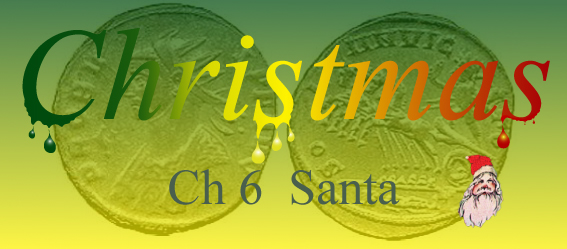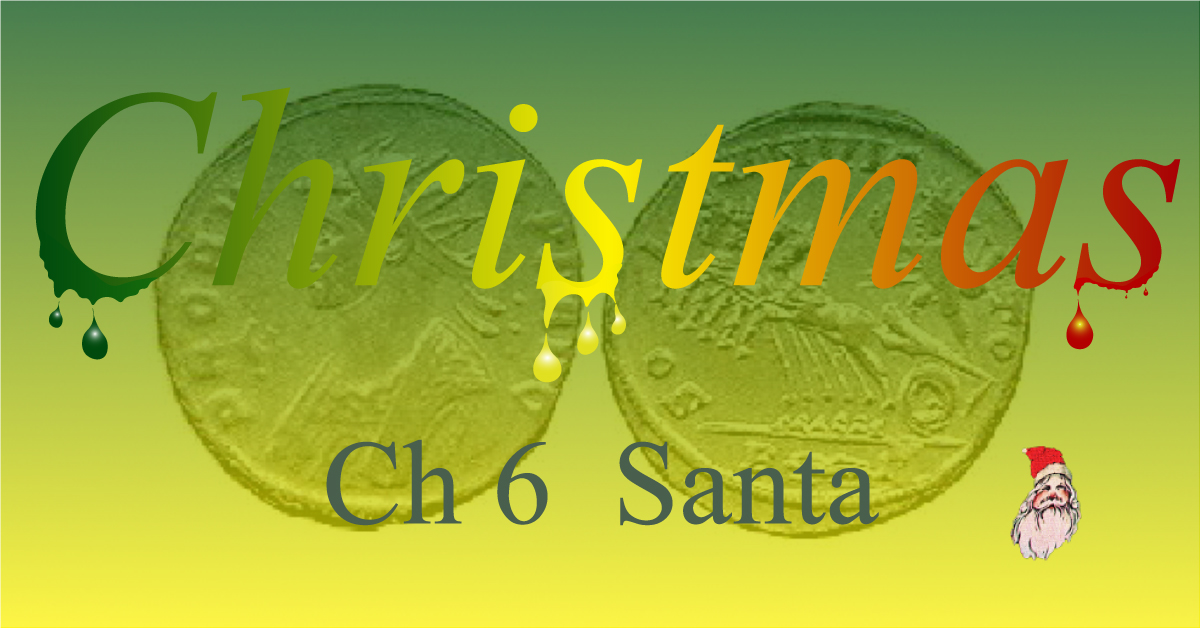So what about Santa Claus? Even poor Santa is not safe. Many credit a Catholic Bishop named St. Nicholas, who lived during the fourth century, as the basis for the Santa myth. St. Nicholas is known by several other names such as Nikolaos of Myra, Nikolaos of Bari, and Nikolaos the Wonder Worker. The mythical character of Santa Claus takes on several "God like" qualities, and according to the following quote this was the intent from the beginning.
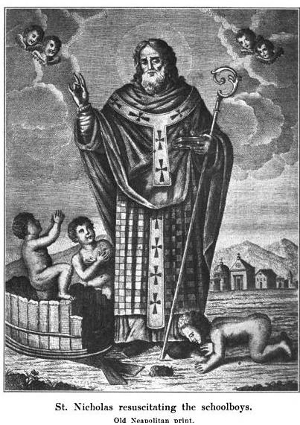
The judge at Christmas was St. Nicholas; on judgment day it was God himself. . . . The parallel was always there and always meant to be there.
St. Nicholas has indeed been seen in times past as a sort of god. There have been many stories passed down about the so-called miracles he performed. Some of these stories are relayed in a book titled The Story of Santa Klaus written by William Shepard Walsh in 1909. One such story, reported there, takes place at a time when the inhabitants of St. Nicholas' diocese, or district, were enduring a very severe famine. Meat was hard to come by, and the people were on the verge of starvation. The villain of the story was a wicked inn keeper who, in secret, kidnapped and killed children. He then used the bodies of the children as the main ingredient in a variety of tasty dishes he prepared and served to his unsuspecting guests. St. Nicholas supposedly visited this inn, and he immediately knew what was being done upon seeing the dish which was served to him. St. Nicholas then went out back and found a tub filled with the bodies of dead children which had been salted in order to preserve their flesh for later consumption. The saint simply made the sign of the cross above the bodies of the children, and they were miraculously restored to life. This image shows the children admiring and bowing to St. Nicholas after the event (Walsh 25-29). Notice the halo surrounding his head which is that relic of sun worship discussed earlier.
Santa is simply another version of the pagan god Saturn.
The name St. Nicholas may have been borrowed from a Catholic saint named Nicholas, but as we have so often seen, the pagan ritual merely adopted a new name with a new perceived meaning. The Santa myth was grown from the pagan root of Saturnalia. One of the common Saturnalian customs reported by all known sources on the subject was the practice of social inversion — the social hierarchy was turned on its head during the feast. The roles were reversed based upon social status. Slaves were served by their masters, and on the surface everyone was seen as equal during the Saturnalia. Part of this social inversion involved selecting a person of low social standing and elevating them to the status of mock King. This mock king was representative of Saturn himself and was given the title of King of Saturnalia or Lord of Misrule for the duration of the celebration. This Lord of Misrule would make ridiculous rules throughout the celebration and also command his new found subjects to do strange things. The King of Saturnalia, as the name implies, took on the authority of a king, and whatever he commanded was done. His commands were usually in the spirit of the festival. Nevertheless, what he said was the rule of law during the Saturnalia. It is this Saturnalian "Lord" which gave birth to the myth of Santa Claus as we see in the following quote.
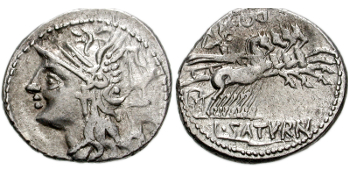
http://www.cngcoins.com
http://commons.wikimedia.org
Mr. Nissenbaum is simply echoing what history has long since made evident. Santa is simply another version of the pagan god Saturn. Mr. Walsh refers to St. Nicholas as "Saturn Christianized and dignified with episcopal robes" (Walsh 76).
As surely as Santa is said to travel through the heavens on a sleigh pulled by reindeer, Saturn is also said to travel through the heavens on a quadriga (Roman chariot) pulled by horses or in some cases winged serpents. This roman coin from the second century B.C. shows Saturn being pulled by horses. The painting by Raphael shows Saturn being pulled through the clouds by winged serpents.
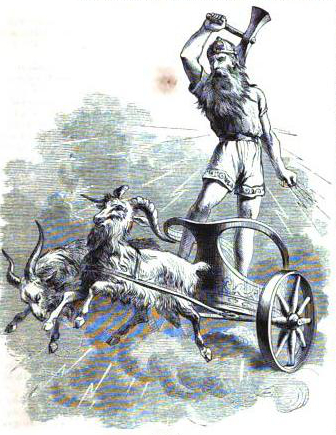
(Spencer 241)
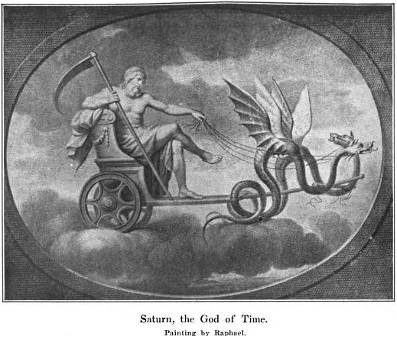
Some who study the subject of Santa find a connection to another pagan deity named Thor. Historians too, have on occasion linked the myths of Saturn with those of Thor. Both rode through the heavens on a cart pulled by animals. Saturn was pulled by serpents or horses as we have just seen; Thor was said to ride through the heavens on a cart pulled by goats. The myths of both pagan deities also involved serpents. Saturn is sometimes depicted with serpents, not only those which pull him through the skies, but he is also sometimes depicted with serpents by his sides or intertwined in a circle about his image. Thor is often depicted doing battle with a serpent. The similarities do not end at the mythical acts embraced by both of these pagan deities. One can also easily see the resemblance in their depictions. Saturn, Thor, and the Santa Claus which has become so familiar to us today, are all usually depicted as older men with flowing beards. It has always been common in pagan circles to adopt the deities of other nations and rename them. Exactly as modern society has adopted the image of Saturn and renamed him Santa or St. Nicholas, so also could a previous religion have mingled the myths of Saturn and Thor.
As surely as there are variations of pagan deities associated with Saturn throughout the world, there are also many variations of Santa Claus throughout the world. Some of these are very different than what is commonly seen in the U.S., as the following quote will illustrate.
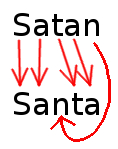 In the myths surrounding Saturn, there seems to be a common theme of the serpent either serving or at least being seen with the pagan god. Christians recognize the serpent as a representation of Satan. Now, in the above quote, we see the sidekick of Saturn's descendant take on another common image of Satan — horns, fiery eyes, long red tongue, and clanking chains. There seems to be a connection between Santa and Satan in most, if not all, of the variations of this mythical gift giver which appear around the world. The connection appears very obvious in some, such as the "hideous Klaubauf" mentioned above with his horns, fiery eyes, long red tongue, and chains. Others are much more subtle as is the case with the American version of Santa.
In the myths surrounding Saturn, there seems to be a common theme of the serpent either serving or at least being seen with the pagan god. Christians recognize the serpent as a representation of Satan. Now, in the above quote, we see the sidekick of Saturn's descendant take on another common image of Satan — horns, fiery eyes, long red tongue, and clanking chains. There seems to be a connection between Santa and Satan in most, if not all, of the variations of this mythical gift giver which appear around the world. The connection appears very obvious in some, such as the "hideous Klaubauf" mentioned above with his horns, fiery eyes, long red tongue, and chains. Others are much more subtle as is the case with the American version of Santa.
The word Santa is a true anagram
for the word Satan.
The Santa commonly recognized by the children in the U.S. is a jolly old man who welcomes children to his knee, but the connection to Satan is still there in the name itself. The word Santa is a true anagram for the word Satan. The transfer from Satan to Santa requires only the movement of the letter "N" from the end, to the middle of the word. This may seem trivial in today's world, but there was great value placed on the anagram in times past, which the following quote reveals.
The fact most variations of Santa have a satanic connection lends credence to the idea the anagram of Santa does indeed point to something of importance in the character and history of the mythological entity. This combined with the fact Santa is the descendant of the Lord of Misrule from the Saturnalia, secures the connection between Santa and paganism and, thereby between Santa and Satan.
Sometimes there is also a connection between Christ and Santa. Another gift-giving counterpart of Santa Clause is Santa Lucia who is also sometimes called the Christ-child. The so-called Christ-child is female, often an adult female, and is sometimes accompanied by a variation of the hideous Klaubauf called Hans Trapp. This Swedish Newspaper article on the subject of Santa Lucia links her to both Christ and Satan. The article is speckled with hints of sun worship sparkling from beneath the surface.
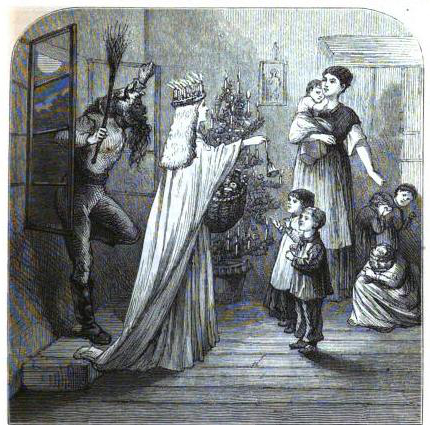
(Spencer 249)
The myth of Santa appears to be worldwide, although the name changes, as we have seen in the above quotes. The Santa of the United States was brought here by John Pintard in 1810. The image of Santa has been shaped and molded by others such as Washington Irving, Clement Clarke Moore, Thomas Nast, and the Coca-Cola Company. Some credit Santa's red coat to the Coca-Cola Company which, in 1931, contracted with Haddon Sundblom to create a coke drinking Santa in a "Coca Cola red" coat. However, there are many writers who described Santa's coat as being red prior to 1931. For example, Mr. Walsh, in his book The Story of Santa Klaus published in 1909, describes St. Nicholas as having a ruddy face, white beard, and a bright red robe lined with soft white fur (Walsh 198). The red color likely goes all the way back to the Saturnalia, and is possibly associated with the color of blood due to a sacrificial rite. The Coca Cola drinking Santa has endured, however, as an iconic symbol of commercialism and materialism.
Modern society needed very little help in creating a mythological being of its own in Santa Claus. The origins of St. Nicholas may have come from the Saturnalian Lord of Misrule, but Santa has taken on the kind of powers only God Himself enjoys at the hand of modern society. This god of materialism has been developed through years of refinement which make him omnipresent, omnipotent, omniscient and everlasting. In this regard, modern society has outdone their pagan ancestors who selected a Lord of Misrule at the Saturnalia. The King of Saturnalia took on none of these God like characteristics. Yet, the seventeenth century Puritans understood the dangers behind Christmas customs such as the Lord of Misrule and took action to stop them.
Regardless of where the Santa myth is observed in today's world, he or she always possesses supernatural abilities. In fact, the Santa myth embodies the same characteristics as the very real God of the Bible. The myth of Santa is thought of as being everlasting, meaning he does not die. Santa is said to be omnipresent, meaning he can be everywhere at once. He is said to be able to visit every house on earth in a single night. He is portrayed as being omniscient, meaning he knows everything. He is said to know when children are naughty or nice. Children are taught to view him as being omnipotent, meaning he can do anything. Many children believe Santa can grant whatever wish they ask of him, and Children, as well as adults, do ask things of him. They pray to him in the same way people pray to God or to other gods.
(2): a set order of words used in praying
b: an earnest request or wish" ("Prayer").
 This definition of prayer makes very clear what people do in reference to Santa is indeed prayer. This image showing a request for Santa to bring the troops home safely was being passed around Facebook in 2015. Some may think we must assume a certain physical position, such as kneeling, for our request or thanksgiving to be considered a prayer. Obviously this is not truly the case though. People often pray to God while in positions other than kneeling. We may not like the idea of labeling a child's request to Santa as a prayer, but this is indeed what it is. A child who is taught to believe in Santa does just that. They believe in Santa. They believe in Him in the same way we believe in God. They have the same hope of Santa fulfilling their request as adults have of God fulfilling their request. There can be no doubt Santa is transformed into an idol in the mind of a believing child. This is a very serious topic parents should give much thought to. The tradition of teaching children the myth of Santa is often seen as a rite of passage for the child. However, the thoughtful parent must look at this from a Biblical standpoint before simply engaging in this tradition. Compare this tradition with Biblical principles.
This definition of prayer makes very clear what people do in reference to Santa is indeed prayer. This image showing a request for Santa to bring the troops home safely was being passed around Facebook in 2015. Some may think we must assume a certain physical position, such as kneeling, for our request or thanksgiving to be considered a prayer. Obviously this is not truly the case though. People often pray to God while in positions other than kneeling. We may not like the idea of labeling a child's request to Santa as a prayer, but this is indeed what it is. A child who is taught to believe in Santa does just that. They believe in Santa. They believe in Him in the same way we believe in God. They have the same hope of Santa fulfilling their request as adults have of God fulfilling their request. There can be no doubt Santa is transformed into an idol in the mind of a believing child. This is a very serious topic parents should give much thought to. The tradition of teaching children the myth of Santa is often seen as a rite of passage for the child. However, the thoughtful parent must look at this from a Biblical standpoint before simply engaging in this tradition. Compare this tradition with Biblical principles.
Is it true? Does Santa exist and can he do all of those things which make him so great in the mind of a child? The answer is, of course, no. He does not exist and can do nothing. Therefore, if we tell a child he does exist, we are lying to that child. We know what the Bible says about lying.
Children have the same hope of Santa fulfilling their request as adults have of God fulfilling their request.
Exo 23:1 Thou shalt not raise a false report: put not thine hand with the wicked to be an unrighteous witness.
Exo 23:2 Thou shalt not follow a multitude to do evil; neither shalt thou speak in a cause to decline after many to wrest judgment:
The Bible clearly tells us not to lie even if everyone else is lying. Jesus tells us Satan is the father of the lie, and when we engage in lies, we are following Satan.
Joh 8:44 Ye are of your father the devil, and the lusts of your father ye will do. He was a murderer from the beginning, and abode not in the truth, because there is no truth in him. When he speaketh a lie, he speaketh of his own: for he is a liar, and the father of it.
Many will say there is no harm in a small lie. The Bible is clear on the subject, and teaching children about Santa is no small lie. Children idolize Santa as already discussed. They make their request known to Santa. This is, by all definitions, praying to a mythological creation of man who has taken on the qualities of a god. The Bible is clear about this also. This violates the first of the Ten Commandments.
Exo 20:3 Thou shalt have no other gods before me.
Man has also created an image of Santa. There are paintings and statues made of stone, wood, rubber, and plastic. These paintings and statues depict a jolly old man in a red suit with a bag of presents being pulled through the sky by a team of mythological beasts. Therefore, the child is able to conjure up an image as they present their petition before this man made god through prayer. This violates the second of the Ten Commandments.
Exo 20:4 Thou shalt not make unto thee any graven image, or any likeness of any thing that is in heaven above, or that is in the earth beneath, or that is in the water under the earth:
The next part of this second commandment tells us why this practice is so dangerous and it has to do with the children.
Exo 20:5 Thou shalt not bow down thyself to them, nor serve them: for I the LORD thy God am a jealous God, visiting the iniquity of the fathers upon the children unto the third and fourth generation of them that hate me;
In the case of the Santa myth, once the idol is made, it is worshiped, not by the maker, but by the child who is taught the myth. Then, through the actions of those who partake in the Santa myth, the iniquity is passed to the third and fourth generations. Once one parent teaches his or her child the Santa myth, the cycle is begun, and that child will most likely to teach his or her child the same myth. The wheel of idolatry is set in motion gaining momentum with each passing generation. The responsibility falls on the Christian parent to exit the freeway of idolatry traveled by the masses. Christian parents must apply the brakes to idolatry in their generation to prevent the wheels from churning those generations which follow. Christians must stand firm on the foundation of truth and teach the children likewise. Then the promise in the remainder of the commandment will be recognized.
Exo 20:6 And shewing mercy unto thousands of them that love me, and keep my commandments.
Christ Himself gives a very stern warning to anyone who teaches lies to a child.
Luk 17:1 Then said he unto the disciples, It is impossible but that offences will come: but woe unto him, through whom they come!
Luk 17:2 It were better for him that a millstone were hanged about his neck, and he cast into the sea, than that he should offend one of these little ones.
Christian parents must heed the words of our Savior and be very careful what they teach their children. Christ is our example and He never lied.
1Pe 2:21 For even hereunto were ye called: because Christ also suffered for us, leaving us an example, that ye should follow his steps:
1Pe 2:22 Who did no sin, neither was guile found in his mouth:
Before leaving this all important topic, I want to relay one last message which demonstrates the allure of Santa to a child. I can speak from my own personal experience in regard to children idolizing Santa. I was taught as a child Christmas was to be avoided but was later told it was alright. Our family had our first Christmas celebration when I was 13 years old.
She seemed perfectly fine with the fact her daughter had left her side in a busy store to come visit me.
As an adult, I continued to engage in the festivities of Christmas in all the traditional ways. This ended when I took the time to study the holiday and the Bible for myself. The following experience, while not a turning point, was at least in part what led me to search out the truth of Santa and Christmas.
As an adult, I once played the character of Santa Claus at one of the national chain stores as a favor to the Manager of the store. This was before I studied about Christmas and truly realized the nature of the holiday. Frankly, the experience of playing Santa scared me. It scared me for the safety of the children. They idolized me because of the suit I was wearing. I have never had anyone look at me the way those children looked at me. There was one little girl in particular who could not take her little blue eyes off of Santa. She sat on my lap and made her request known to me. The camera flashed marking the moment her turn was over, but she still could not take her little admiring eyes off of me. Those precious little blue eyes stared intently at me as her mother clasped her hand and led her away. Her focus was on me and only me. She turned her head as far left as she possibly could so she could watch me as she was led away. Her appearance was unnatural. Her body was walking forward, but her head was facing directly behind her at me. Her mother turned right down the main isle, and the little girl quickly swung her head all the way around from far left to far right. The movement was reminiscent of a duck's ability to turn its head to the rear. She maintained the uncomfortable pose in order not to miss a single instant of that red suit I was wearing. Several minutes later I noticed those same little blue eyes peering around the end of the store shelving at me. Her mother was nowhere in sight. The little girl had found a concealed place near the edge of the store where she could get a close, uninterrupted, view of the jolly old man in the red suit. She stood there a few feet away staring at me from amid the merchandise. I did not have anyone waiting in line, so I held out my hand to her. She was shy at first, but overcame her shyness quickly enough. The camera man and I talked with her for several minutes until a surprisingly calm mother showed up looking for her. Her mother did not know me. She had no idea of the character of the man who wore that red suit. However, she seemed perfectly fine with the fact her daughter had left her side in a busy store to come visit me and run her fingers through my long white fake beard. I think the mother even apologized to me as she led the little girl away again.
Is Teaching Kids the Myth of Santa Safe? Or Is This a Dangerous Practice Physically and Spiritually?
1. The parallel between God on judgment day and Santa at Christmas was always meant to be there.
2. Santa is simply another version of the pagan god Saturn.
3. Saturn was represented at the Saturnalia by the Lord of Misrule or King of Saturnalia. Santa is an extension of these characters and is represented by men at Christmas which originated, in part, from the Saturnalia and occurs at the exact same time of year.
4. Santa is also connected to the pagan deity Thor in the same manner as Saturn.
5. There is a connection between Santa and Satan in most, if not all, of his variations around the world.
6. The word Santa is a true anagram for the word Satan.
7. The Santa myth embodies the same characteristics as the one true God; Santa is said to be omnipresent, omnipotent, omniscient, and everlasting.
8. Santa is a god of materialism.
9. Children pray to Santa in the same way people pray to other pagan gods or to the One True God.
10. Children have the same hope of Santa fulfilling their request as adults have of God fulfilling their request.
11. Santa does not exist and can do nothing. Therefore, if we tell a child he does exist, we are lying to that child.
12. Propelling the Santa myth violates at least two of the Ten Commandments as well as other Biblical principles such as not lying and not offending children.
13. Children, and often parents, are overly trusting of people wearing Santa costumes.
Our next step through the rituals of Christmas will focus on one of the main activities of Santa, the giving of gifts.
